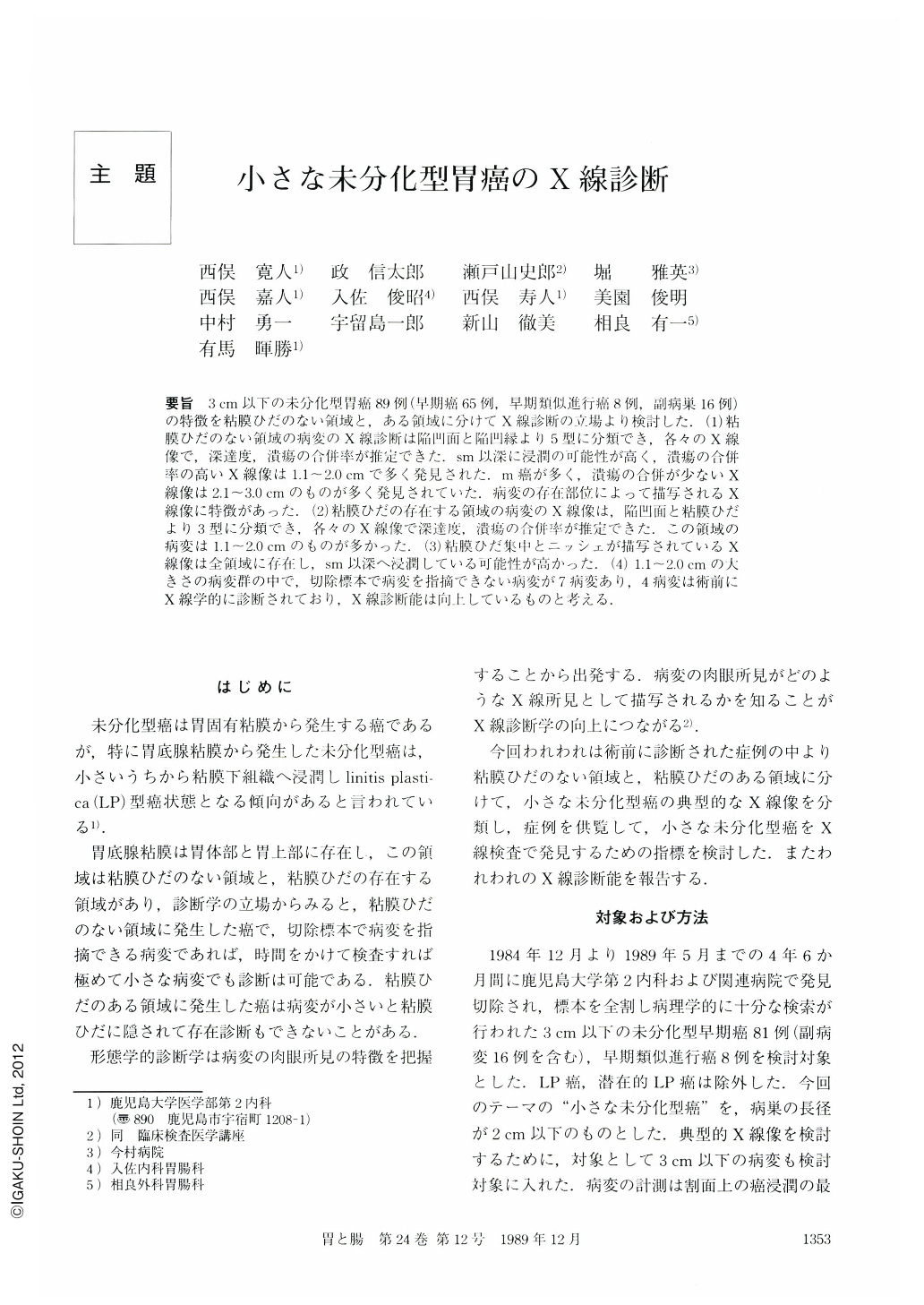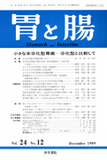Japanese
English
- 有料閲覧
- Abstract 文献概要
- 1ページ目 Look Inside
- サイト内被引用 Cited by
要旨 3cm以下の未分化型胃癌89例(早期癌65例,早期類似進行癌8例,副病巣16例)の特徴を粘膜ひだのない領域と,ある領域に分けてX線診断の立場より検討した.(1)粘膜ひだのない領域の病変のX線診断は陥凹面と陥凹縁より5型に分類でき,各々のX線像で,深達度,潰瘍の合併率が推定できた.sm以深に浸潤の可能性が高く,潰瘍の合併率の高いX線像は1.1~2.0cmで多く発見された.m癌が多く,潰瘍の合併が少ないX線像は2.1~3.0cmのものが多く発見されていた.病変の存在部位によって描写されるX線像に特徴があった.(2)粘膜ひだの存在する領域の病変のX線像は,陥凹面と粘膜ひだより3型に分類でき,各々のX線像で深達度,潰瘍の合併率が推定できた.この領域の病変は1.1~2.0cmのものが多かった.(3)粘膜ひだ集中とニッシェが描写されているX線像は全領域に存在し,sm以深へ浸潤している可能性が高かった.(4)1.1~2.0cmの大きさの病変群の中で,切除標本で病変を指摘できない病変が7病変あり,4病変は術前にX線学的に診断されており,X線診断能は向上しているものと考える.
(1) Using 89 cases of undifferentiated cancer of the stomach measuring 3 cm or less in the longest diameter (early cancer 81 cases including 16 cases of secondary lesion, advanced cancer simulating early gastric cancer 8 cases) as the subjects, study was conducted regarding the size of the lesions, depth of invasion and presence or absence of accompanying ulcer. With the range of the size,0 to 0.5 cm, all cases were m cancers with no accompanying ulcer. With the range of 0.6 to 1.0 cm, sm deep cancer accounted for 36% (4/11) and Ul (+) for 27% (3/11). With the range of 1.1 to 2.0 cm, sm deep cancer accounted for 37% (17/46) and Ul (+) for 33% (15/46), and with the range of 2.1 to 3.0 cm sm deep cancer accounted for 39% (9/23) and Ul (+) for 46% (11/23).
(2) On 70 cases in which roentgenograms pertinent for interpretation were obtained, reviews were made regarding the location of cancer, depth of invasion and the presence or absence of accompanying ulcer.
1. In the area without mucosal folds, there were 32 lesions of m cancer, 14 lesions of sm cancer and 2 lesions of pm deep cancer, and the proportion of accompanying ulcer being 31, 50, 100%, respectively. In the area with mucosal folds, there were 11 lesions of m cancer, 5 lesions of sm cancer and 6 lesions of pm deep cancer, and the proportion of accompanying ulcer being 36, 60, 17%, respectively.
2. Roentgenograms were classified into five types, Ⅰ-Ⅴ, for cases in which the lesions were located in the area without mucosal folds and into three types Ⅵ-Ⅷ for cases in which the lesions were located in the area with mucosal folds according to the findings of concavity, concave margin and mucosal folds. The relationships between each type and the depth of invasion, the size of the lesion, location and the presence or absence of accompanying ulcer were studied. The proportion of types Ⅰ-Ⅳ was 79% (19/24) in m cancer and only 8% in Ul (+) (2/24). The proportion of type Ⅴ was 56% (10/18) in m cancer and 61% in Ul (+), higher than types Ⅰ-Ⅳ. The proportion of types Ⅰ, Ⅱ, Ⅲ and Ⅴ was 72% among lesions measuring 2.0 cm or less (23/32) and that for type Ⅳ was 60% among lesions measuring 2.1 to 3.0 cm (6/10). Type Ⅱ was often found in the upper part of the stomach, type Ⅲ near the angulus and types Ⅳ and Ⅴ in the anteroposterior wall of the body. The proportion of type Ⅵ was 75% (3/4) among m cancer and only 25% (1/4) among Ul (+). The proportion of type Ⅶ was 36% (3/8) in m cancer with accompanying ulcer. Type Ⅲ was found only in 1 case (sm cancer) with ulcer. The proportion of type Ⅵ-Ⅷ was 85% (11/13) among the lesions of 2.0 cm or less. Type Ⅵ was often found in the lower part of the body and types Ⅶ and Ⅷ from the center of the body to the upper part of the stomach. Type Ⅸ was noted throughout the stomach, with the proportion 47% (7/15) in m cancer and 80% (12/15) in Ul (+).
(3) Of 18 cases in which presence of the lesion was not able to be diagnosed from the resected preparation, 2 out of the 9 lesions measuring 0 to 0.5 cm, 1 out of the 2 lesions measuring 0.6 to 1.0 cm and 4 out of the 7 lesions measuring 1.1 to 2.0 cm had been radiologically diagnosed.

Copyright © 1989, Igaku-Shoin Ltd. All rights reserved.


